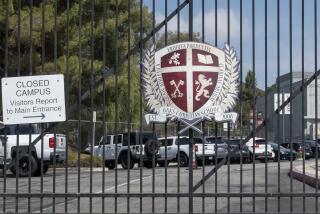Report Finds Alienation Among Latino Students : Schools: Study by Thousand Oaks High School student government also shows classmates are concerned about gangs.
- Share via
A survey of attitudes at Thousand Oaks High School has found that many in the school’s growing Latino population feel alienated.
And the same survey, conducted by a committee of student government leaders, shows that students at large are concerned about increasing numbers of gang fights near campus.
Although stressing that problems described in their unscientific report are not yet serious, the students are calling for the board and administrators of the Conejo Valley Unified School District to take action before matters worsen.
Conclusions from the report, gathered during the school year, gained new urgency among students interviewed Monday following a fatal shooting Saturday night between rival Thousand Oaks and Camarillo gang members.
An 18-year-old Camarillo man was killed and a Thousand Oaks woman whose younger sister attends Thousand Oaks High School was seriously wounded.
A 16-year-old boy from Thousand Oaks arrested Sunday was released Monday, but he remained a suspect in the killing, police said. His name was not released because he is a minor.
“We don’t want to have somebody killed on campus before attention is paid to our gang problem,” said senior Sohail Malad, 18, a member of the committee that conducted the survey and a student representative on the school board for the last two years.
“We don’t want a major crisis to spur a study,” added committee member Michelle Penfield, 18, a senior at the school. “We want to solve these problems before they’re unfixable.”
Principal Keith Wilson agreed that gangs represent a potential threat, but he said they haven’t posed significant problems on campus because school administrators and police already work together to keep the situation in check.
“This is real, and what happened this weekend is scary,” Wilson said.
About 300 of the school’s 2,200 students were surveyed for the report, titled “Student Voice.” Of the 300, about 200 answered written questionnaires and 100 participated in group interviews with committee members.
Respondents were randomly selected from a list of students recommended by teachers. To ensure that the survey reflected the school’s growing ethnic diversity, the committee used an interpreter to interview students in English as a Second Language courses.
About half of the students surveyed said they did not perceive any racial tensions on campus, the survey said. Minorities, who make up 15% of the school’s population, were more likely to see racial tensions than non-minorities, the survey found.
“People from a minority background think the problem is much worse than people of a majority background,” said Aaron Winn, 17, a junior and member of the survey committee.
The population of Latinos throughout the Conejo Valley district has doubled in the last four years to about 8% of the 17,700-student population.
Part of the problem expressed by newly arrived Latino immigrants was the language barrier, which made them feel isolated from the rest of the student population, the survey found. The number of racially motivated fights was on the rise, the survey said.
Some Latinos said they joined gangs to stick together against perceived threats from other students, and some said they felt the need to carry weapons to protect themselves, the survey found. Still, 83% of students said they felt safe at school.
The report stressed that students from every ethnic group belong to gangs, and only a handful of the students surveyed expressed affiliation with a gang, the students said.
“But just that it exists is scary,” said Brandon Savade, 16, a junior on the committee.
The report also surveyed student opinions about student government, in which a majority of respondents said they believed that a small percentage of “elite” students were not effectively representing all students at the school.
About 50 students participate in student government, acting as a liaison between the administration and students, including elected leaders such as the student body president and vice president.
As a result of the study, the student government may form a task force next year to look at ways to encourage more students to get involved, the committee said.
Administrators and student leaders are also looking at forming a dispute mediation panel in which students would help their peers resolve problems peacefully, Wilson said.
Other plans being considered include creating a “buddy system,” in which students struggling with English would be paired with someone from another culture to reduce the isolation, Wilson said.
Whatever results it may or may not bring, part of the survey’s aim is to create a dialogue among students, said Claudia Spelman, the district’s coordinator of pupil services.
“Once anybody names a problem, as long as they’re willing to work on it, I think that’s really healthy,” Spelman said.
More to Read
Sign up for Essential California
The most important California stories and recommendations in your inbox every morning.
You may occasionally receive promotional content from the Los Angeles Times.










